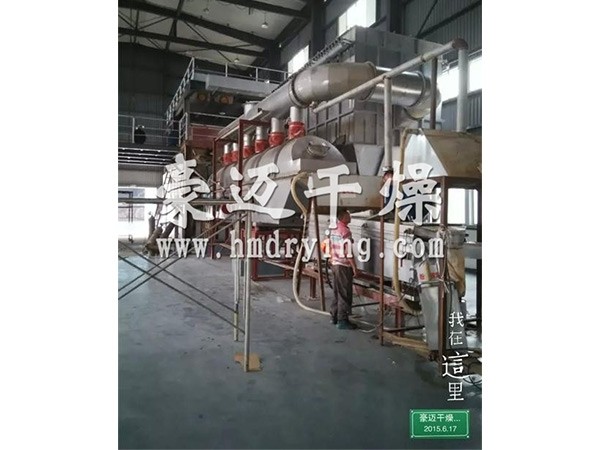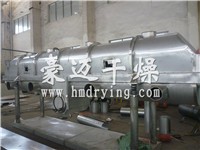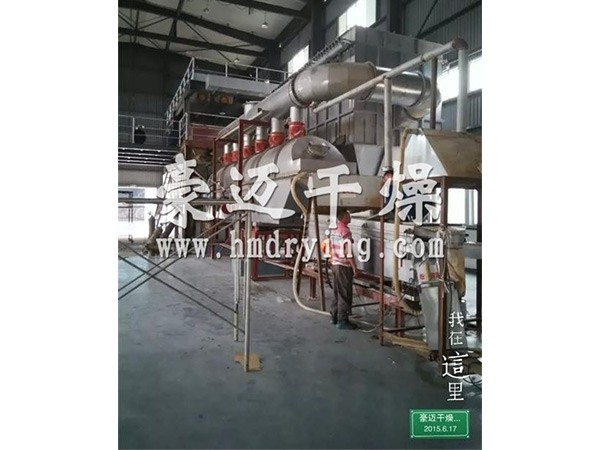Description
Classification: Food Engineering Industry
Case summary: the brown sugar production line designed by Changzhou Haomai drying Engineering Co., Ltd. based on the process technology and rich practical experience, meets the requirements of users for producing high-quality brown sugar. The production line of brown sugar adopts the combination of drying and cooling fluidized bed in series, which can not only meet the requirements of moisture drying of products, but also meet the requirements of subsequent packaging of products.
Brown sugar drying production line
1、 Equipment design conditions:
1. Material conditions
Material name: brown sugar
Initial moisture: 4%
Final moisture: 0.5%
Treatment capacity: 2000kg / h
Raw material temperature: 15 ℃
Specific gravity of material pile: about 0.8t/m3
Product temperature: below 50 ℃
Working environment: altitude 1300 m
2. Process conditions
Drying method: linear vibrating fluidized bed
Contact mode of material and hot air: through flow type
Heat source and heating mode: steam (provided by users) (steam temperature is about 150 ℃ - 160 ℃)
Drying air inlet temperature: 70 ℃
Drying exhaust temperature: 50 ℃
Product discharge mode: main engine
Dust removal method: Cyclone
3. Design meteorological conditions
Atmospheric pressure: 81kpa
Ambient temperature: 20 ℃
Relative humidity: 33%
4. Public works
4.1 power supply
Power supply: 380V, 3-phase, 50 Hz
Power: 51kw
4.2 steam consumption: 420-480kg / h
2、 Type selection design and calculation of drying linear vibrating fluidized bed:
1. Determined parameters
(1) Wet material handling capacity of 2000kg / h
(2) Drying air inlet temperature T1 = 70 ℃
(3) Drying exhaust temperature T2 = 50 ℃
(4) Moisture content of raw material on wet basis ω 1 = 4%
(5) Moisture content of product on wet basis ω 2 = 0.5%
(6) Ambient temperature t0 = 15 ℃, relative humidity: 75%
(7) Air moisture content at ambient temperature d0 = 0.01kg water / kg dry air
(8) The raw material temperature is 20 ℃, that is, θ 1 = 20 ℃
(9) The product temperature is 20 ℃ lower than the exhaust temperature, that is, θ 2 = 50 ℃
(10) In indirect heat transfer, D1 = d0 = 0.01kg water / kg dry air
3、 Main engine selection of drying fluidized bed
1. According to the production practice of similar materials in the vibrated fluidized bed, and combined with the residence time of materials in large-scale vibrating fluidized bed, the drying time of materials in the equipment is set as 6 minutes, and the spreading thickness is 2-5cm
1.1 the volume of material to be treated per hour v = 2000 / 800 = 2.5m3 (specific gravity of material is about 0.8g/cm3, estimated)
1.2 if the batch of materials that can be processed per hour P = 60 / 6 = 10 batches, then the volume of each batch of materials to be processed
V batch = 2.5 / 10 = 0.25m3/batch
1.3 according to the average spreading thickness of materials in the vibrating fluidized bed dryer is 3.0 cm,
The area of fluidized bed is 0.25 / 0.03 = 8.33 m2
2. Bed area of drying bed a
A = 1.2 × 7.5 = 9 m2, and > 8.33 M2 is considered to be basically reasonable.
3. Drying bed grouping design
according to the design experience, 7.5m is divided into four sections.
4. To sum up, the model zlg1.2 × 7.5 is selected.
Adjustment and determination of technical parameters of drying part
5.1 the opening rate and perforation gas velocity of the fluidized bed plate are generally controlled at 3-8%, and the perforation gas velocity is 8-12 M / s. For this kind of material, the dehydration rate is small, but the final moisture requirement is strict. The high wind rate should be used for dehydration treatment. The perforation gas velocity is 14m / s, and the bed plate opening rate is 5.2%
5.2 air volume of drying bed system:
L=20000m3/h
5.3 the main force of vibrating fluidized bed is vibration motor. It is necessary to vibrate and fluidize the whole bed and the materials on the bed. A total of two vibration motors with a total excitation force of more than 12t are selected.
5.4 in consideration of the width, stability and vibration efficiency of the fluidized bed, the upper and lower bed body is separated, the bed body is fixed and connected with the incoming conveyor belt or coarse crusher, the lower bed body is vibrated with animal material, and the upper and lower bed body is connected with soft connection.
The brown sugar production line designed by Changzhou Haomai drying Engineering Co., Ltd., based on the technology and rich practical experience, meets the requirements of users for producing high-quality brown sugar.
The advantages of brown sugar fluidized bed dryer are as follows:
1. The brown sugar production line adopts the combination of drying and cooling fluidized bed in series, which can not only meet the requirements of product moisture drying, but also meet the requirements of product subsequent packaging.
2. Drying and cooling medium circulation system: blower, heater and air inlet pipe are all made of stainless steel to avoid contamination caused by unclean air.
3. The bed body of main engine adopts circular arc structure, which increases boiling height and reduces dust entrainment.
4. The air equalizing hole of the bed board adopts the combined structure, the front section adopts the tongue type hole, so that the wet material can move forward smoothly without leakage, and the middle and rear section adopts the straight hole to increase the residence time of the material, which makes the wet material contact with the hot air more fully and improves the drying efficiency.
5. The lower bed of the main engine adopts plate structure and is supported by stainless steel seamless steel pipe. The bed structure is solid and has long service life.
6. The inner part of the lower bed of the main engine is made of stainless steel full welding, so as to avoid the sewage entering into the insulation layer during cleaning, thus affecting the product quality. Moreover, the cleaning outlet and sewage outlet are designed to facilitate the cleaning of the equipment.
7. The system adopts two-stage dust removal, one-stage cyclone separator and two-stage water film dust collector to improve the fine powder recovery rate, and the material liquid in the water film dust collector can be returned to the previous process for secondary utilization.







